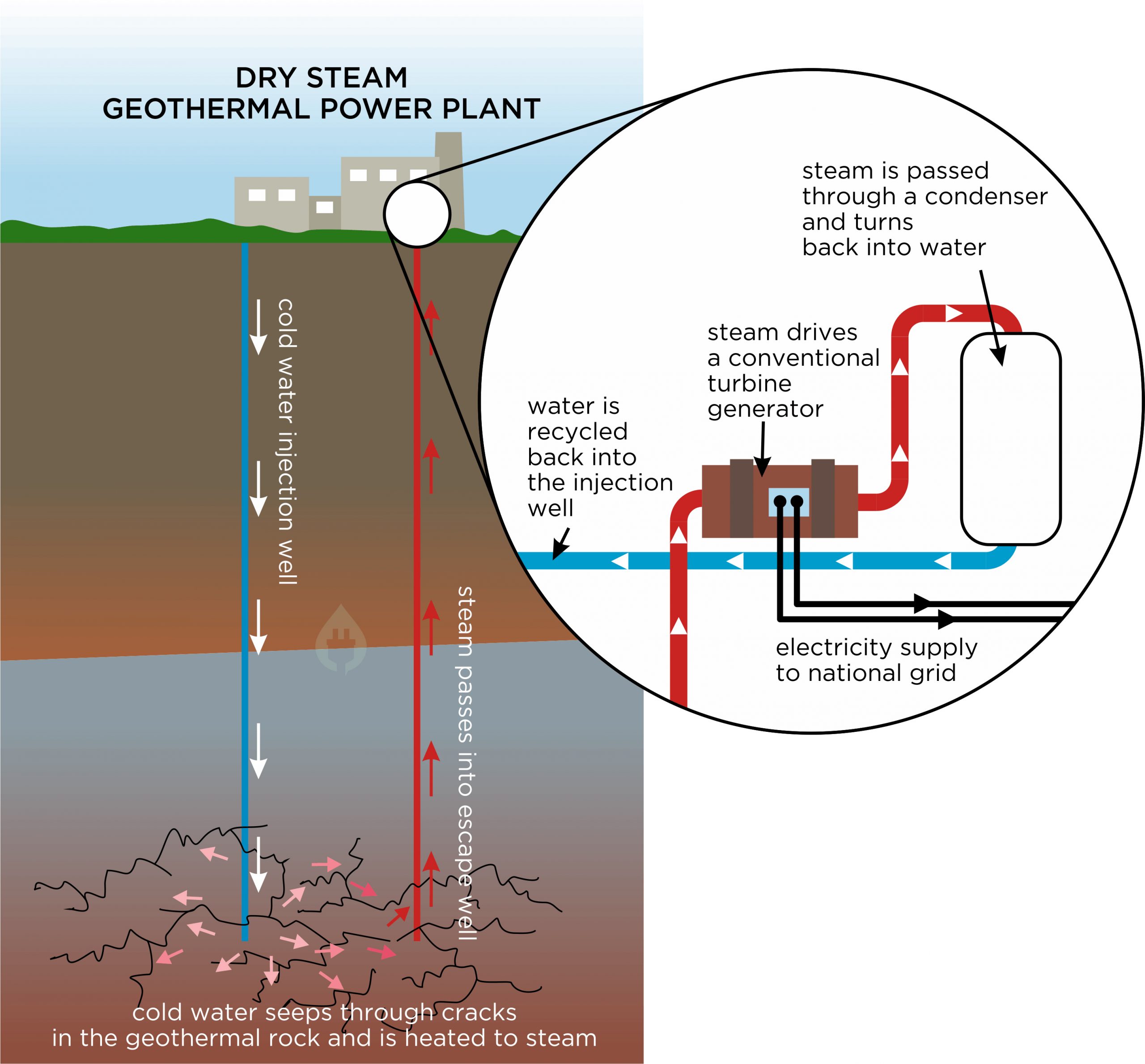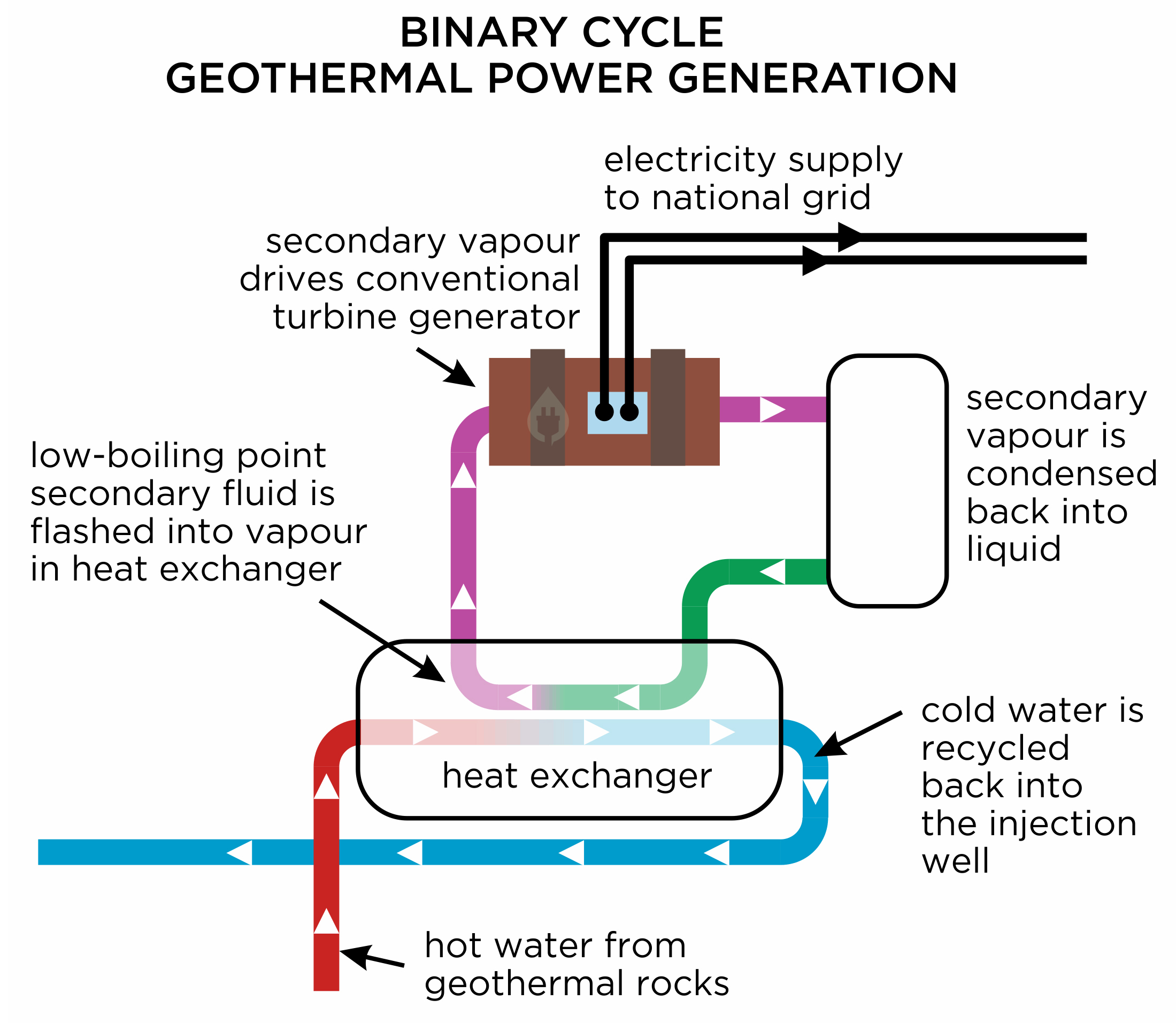Geothermal Energy is heat that is trapped in rocks deep below the surface of the earth. By drilling holes into these rocks, that energy can be released and used to generate electricity or heat buildings.
The
majority of geothermal energy comes from naturally occurring radioactive elements deep within the earth’s rocks. All radioactive elements continuously undergo a process called decay, which causes them to continuously give off heat. Radioactive elements found within geothermal rocks can decay for tens or even hundreds of thousands of years, meaning that geothermal energy is a long term source of heat. Geothermal energy is thus categorized as a renewable form of energy generation.
How deep you have to go to find sufficient geothermal energy to drive electricity generation plants depends on what kind of rocks are below the surface. As a general rule, the deeper down into the ground you go, the higher the rock temperature becomes. Most commercial geothermal energy wells descend 1 km – 4 km below the surface.
Although some locations, like Iceland, have abundant, much more readily-accessible geothermal energy sources due to their geology. Iceland is located on the meeting place of two diverging tectonic plates which means it has much higher levels of volcanic activity, exposing many natural hot springs where geothermally heated water arrives at the surface(1).
The world’s biggest geothermal energy electricity generation field is The Geysers in the Mayacamas Mountains, California, USA. This approximately 30 square mile field has just over 1.5 Gigawatts (GW) of electrical generation plants installed, with approximately 900 Megawatts (MW) available(2).
The hotter the rocks, the more energy can be extracted from them, and the more cost-effective the geothermal power plant can be. An exploratory geothermal well in Norway called IDDP-2 was the first to achieve what is called a supercritical temperature, reaching a depth of just over 4½ km and a temperature of 426 degrees Celsius at a pressure of 340 bars(3).
The world’s first commercial geothermal power plant was built over natural steam vents in the ground at a place called ‘Devils Valley’ near Larderello, Italy in 1913. When it became operational in 1913, this power plant generated 250 kilowatts (kW) of electricity.
Extracting Geothermal Heat
There are three different ways that geothermal power plants can transport the heat from the geothermal rocks up to the surface: Dry Steam, Flash Steam, and Binary Cycle.
Dry Steam
Dry steam geothermal plants are the oldest and simplest type of plant. Due to very particular geological requirements to operate, they are not commonly built any more.
Two boreholes are drilled down to the geothermal rock layer. Through one borehole, cold water is pumped down into the geothermal rocks. That cold water permeates through fissures in the rocks and is heated to become steam (see illustration below).
The steam escapes from the rocks through the second borehole, making its way back to the surface under the high pressures in the geothermal rocks. Hot water (or steam) that comes back out of a geothermal well is called ‘produced water’. That steam is then fed into conventional turbines at the surface, where electricity is generated and fed into the national grid.
The steam passes into a condenser which cools it and turns it back into water. This water is recycled back into the ground to be heated again.

Flash Steam
Flash steam geothermal plants work in a similar way. Cold water is pumped into the injection well, where it seeps into the rocks and is heated by the geothermal rocks, just the same as the dry steam plants. However, due to different temperatures and pressures below ground, the water comes back up out of the escape well not as steam, but as hot water under high pressure.
This hot, high pressure water is fed into a flash chamber, where the pressure is reduced quickly, causing the water to convert instantly to steam. This steam then drives the turbine generators as before.
Binary Cycle
Binary cycle is a more recent design of geothermal power plant. The significant advantage this design has over dry steam and flash steam is that it works with much lower temperature water. A water temperature as low as 57 degrees Celsius has been demonstrated to be sufficient for a binary cycle plant(4), meaning they can be used in locations where deep drilling is not practical.
Binary cycle plants start the same way as dry steam and flash steam – cold water is pumped into the geothermal rocks through an injection well. The water is heated by the rocks, and rises back up through the escape well.
The hot water feeds a heat exchanger, where it heats a fluid in a separate, secondary circuit. The secondary fluid has a much lower boiling point than water, so the hot water flashes the secondary fluid into vapour, which then drives a conventional turbine. The secondary fluid is then condensed and fed back into the heat exchanger.
Environmental Considerations
Induced Seismicity
Induced seismicity means small earthquakes caused by human activities. Deep drilling and injecting water into the ground can affect the stresses and strains on natural fault lines in the rock strata. A study published in 2017(5) concluded that fluid injection into the ground at The Geysers geothermal power field caused induced seismicity. Managing induced seismicity is a critical consideration while operating a geothermal energy field.
Gases, Radioactive, and Poisonous Elements
Produced water from deep geothermal rocks carries a number of gases back to the surface, notably carbon dioxide (CO2) and methane (CH4). These gases must be removed from any exhaust from the plant because if they are allowed to escape into the atmosphere, they contribute to global warming.
Studies have shown that current average total life cycle CO2 emission for geothermal power plants is 45kg of CO2 per Megawatt-hour (MWh) generated(6). This compares very favourably with coal generation power plants, which emit on average over 1000kg of CO2 per MWh generated(7).
Natural radioactive and poisonous elements in the geothermal rocks can leach into the water pumped into the well, and when that water returns to the surface as produced water, it brings these elements with it(8). Efforts must be made to ensure the contaminated water remains in a closed-loop cycle, transporting all the contaminated water back into the geothermal well, minimizing risks of poisons leaching into surrounding soil.
Land use
On average, a geothermal field needs between 1-8 acres per Megawatt (MW) of generation capacity. This is much less land area than for example, coal-burning power plants, which need approximately 19 acres per MW – note this excludes the land required for mining the coal(9).
Ground Source Heat Pumps
Heat can be extracted from shallow depths (a few meters to around 100m) using a system called a ground source heat pump (GSHP). The temperature of the rocks is too low to be able to generate electricity, but GSHP systems can drive central heating systems much more efficiently than a gas boiler.
GSHP systems operate on a water temperature of 35-45 degrees Celsius, which is lower than gas-fired central heating systems which tend to operate at between 65-80 degrees Celsius. Consequently, GSHP systems are usually coupled with under-floor heating, or larger radiators that are designed to work at lower temperatures.

